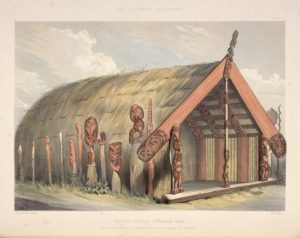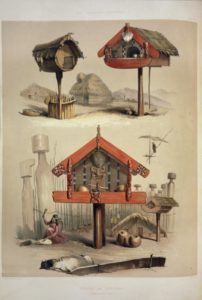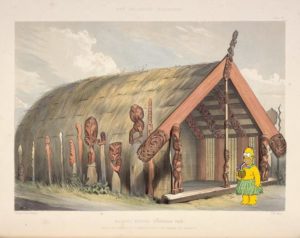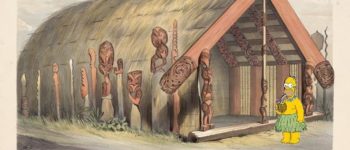1844: George Angas Jr
July 22, 2019
By AHNZ
 Pre-Colonial New Zealand is lost to us in so many ways. The modern Māori revisionism owes its inspiration not to a continuity of transmitted culture but to the visitors who observed and recorded. One such was the visiting¹ artist George Angas Jr.
Pre-Colonial New Zealand is lost to us in so many ways. The modern Māori revisionism owes its inspiration not to a continuity of transmitted culture but to the visitors who observed and recorded. One such was the visiting¹ artist George Angas Jr.
“Like all the Maori works of art, these erections are entirely composed of wood, and other perishable materials; and owing to the humid climate, and the custom of never repairing these sacred edifaces, they soon rot, and fall to pieces. The natives have now ceased to construct works of so much labour and ingenuity, and content themselves with building a raupo hut to dwell in. The consequence is, that in a few years not a single aboriginal edifice, displaying that skill in carving and ornament for which the New Zealanders have been so pre-eminently distinguished among savage nations, will exist throughout the whole country…”- Savage Life and Scenes in Australia and New Zealand, Angas (1847)
 Due to Maori tapu restriction these objects and dwellings were not permitted to be touched or repaired by anyone. They fell apart completely over time. The pictures show us what would otherwise never be guessed at ever having existed.
Due to Maori tapu restriction these objects and dwellings were not permitted to be touched or repaired by anyone. They fell apart completely over time. The pictures show us what would otherwise never be guessed at ever having existed.
Angas spent 6 months exploring and sketching, mostly around Wellington and Taupo. He is at his best, I think, showing the constructions. His Maori portrait style stylises the New Zealanders to look like the Europeans he is used to drawing. The distinctive Maori features are lost as if New Zealand had been transported into the universe of Matt Groening’s The Simpsons. (That’s not a criticism; I’m just saying.)
Meanwhile, the very same loss was happening to personal objects as well as constructions…
“Clothing, weapons and everything else which had belonged to a dead man were tabooed, destroyed or flung to a distance, and could in future belong to no one.- The Whalers, Maynard/Dumas (e.1937)
 So, human taboo actively ensured that Maori artefacts and treasures would not be preserved and passed on. Were we to observe genuine Maori culture then many of the valuable collections in museums, the property of the dead, would be destroyed and certainly never restored or protected.
So, human taboo actively ensured that Maori artefacts and treasures would not be preserved and passed on. Were we to observe genuine Maori culture then many of the valuable collections in museums, the property of the dead, would be destroyed and certainly never restored or protected.
—
1 Voyaged from South Australia on the schooner John Price from July 31 to August 21, 1844 when he landed in Port Nicholson
Image ref. Auckland Art Gallery etc; Digital NZ (Homer Simpson inserted for purposes of commentary)
 Like Comment Share
Like Comment Share





